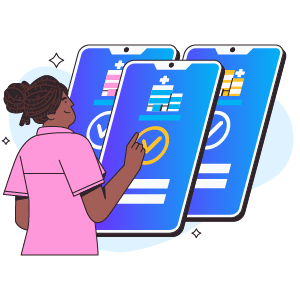Nursing Degrees & Schools / How to Read EKG/EGC
Looking at an EKG can be intimidating at first glance. It can be hard to know exactly what you see just by looking at all those zigzagging lines on a graph.
But with some education, you can learn to read these charts. In this article, we’ll go over the basics of how to read an EKG.
We’ll talk about the different waves and lines that make up an EKG and explain what each one means.
After reading this post, you’ll be able to decipher any EKG chart like a pro! So let’s get started!
Get job matches in your area + answers to all your nursing career questions

What is an EKG?
Chances are you’ve at least seen an EKG a few times in your career. But what is it? An EKG, simply put, measures the electrical activity of a person’s heart. An EKG can detect heart problems such as an irregular heartbeat, heart failure, or a heart attack.
EKG readings also reveal how well your heart works after surgery or other treatment.
How EKGs are used in the workplace
EKGs are an essential diagnostic tool that nurse practitioners and physicians use to treat patients with heart conditions. An EKG is usually one of the first things a nurse or physician looks at when assessing patients’ cardiac health.
Interpreting EKG results, diagnosing heart disease, and prescribing medications are just a few of a nurses’ many responsibilities.
Physicians use EKG results in deciding if a patient requires further testing or certain medications.
How to read an EKG
Reading an EKG can be simple if you understand its different components. So, let’s talk about each one of them!
Heart Rate
The heart rate is how quickly a patient’s heart beats. You can get this information on an EKG by looking at 2 consecutive R-waves. R-Waves are the tallest waves on an EKG strip.
One way to calculate the heart rate is to divide 300 by the number of large squares between them.
There are several other methods you can use.
Rhythm
The heart rhythm describes how evenly spaced out the waves on an EKG are from each other. Evenly spaced waves are called sinus rhythm.
Axis
The cardiac axis is the direction of the heart’s electrical signals. A line on an EKG represents it. The cardiac axis can be normal, left-shifted, or right-shifted. A normal axis is between -30 and +90 degrees. A left-shifted axis is below -30 degrees, and a right-shifted axis is above +90 degrees.
Intervals
Intervals on an EKG refer to the different phases of your heart’s electrical cycle. The main intervals that are measured are the P wave, QRS complex, and T wave. Each of these represents a different stage of your heart’s electrical activity.
P-Wave
A P-wave is an electrical signal produced when the heart’s atria contract. The P wave appears as a small upward deflection on the EKG tracing. Sometimes, P waves can be challenging to see, but they are essential in determining heart rate and rhythm.
QRS Complex
A QRS complex is a waveform in an EKG that represents the beating of the ventricles of the heart.
The QRS complex comprises 3 waves:
- Q wave
- R wave
- S wave
A normal QRS complex lasts 80-100 milliseconds.
ST Segment/T-Wave
The ST segment in an EKG is the section of the strip where the QRS complex end and the T-wave begins. This segment represents the period when ventricular re-polarization is taking place. The T-wave is usually a smooth and rounded wave that represents the recovery phase of the heart’s cycle.
Interpreting the Results
The first step to interpreting EKG readings is knowing how a normal EKG reading appears. Understanding what is normal will help you determine if there are any abnormalities with the different waves we just discussed.
It is not enough to look at each wave independently. You also have to understand their relationship with each other. It may be challenging at first to read an EKG, but it can be a breeze if you practice and get the hang of it.
Next Steps
If you feel uncomfortable with reading an EKG, don’t worry! Seek help from your supervisor or your facility’s educator. By asking questions, you are not only helping yourself. You are also fulfilling your nursing duty as a patient advocate.
Get job matches in your area + answers to all your nursing career questions

Sources
- “State Practice Environment” aanp.org. Accessed August 4, 2022.
- “How to calculate heart rate from ECG” seermedical.com. Accessed August 4, 2022.
- “QRS Complex” healio.com. Accessed August 4, 2022.
- Image from Canva.com
